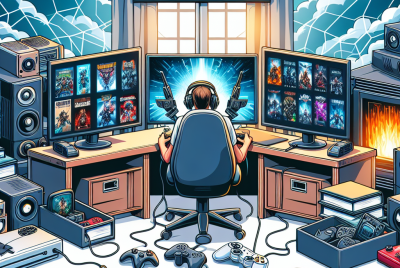The Future of Gaming: VR’s Role in Immersive Experiences
The Evolution of Gaming and the Advent of VR
A Brief History of Gaming
The gaming industry has undergone significant transformations since its inception in the 1970s with pixelated graphics and basic gameplay. As technology evolved, so did gaming experiences, from 8-bit consoles to 3D graphics and online multiplayer environments. The desire for deeper engagement and connection with virtual worlds has been a driving force behind these advancements.
The Birth of Virtual Reality
Virtual reality, or VR, emerged as a concept in the early days of computing but didn't gain traction until the 21st century. With advancements in hardware and software, VR moved from experimental systems to consumer-ready technology. VR headsets, motion tracking, and immersive sound systems can now transport players into alternate realities, creating experiences that were once science fiction.
Today, VR is no longer a novelty for a niche market. Major gaming studios are investing heavily in VR development, leading to a surge in content and hardware options. From immersive story-driven adventures to competitive multi-player environments, VR is reshaping how gamers interact with their favorite titles.
The Mechanics of Immersion
To understand the impact of VR on gaming, it's important to define immersion. It refers to a player’s ability to feel completely engrossed in a virtual environment. In traditional gaming, players are often aware they are just controlling a character on a screen. However, VR breaks down that barrier, allowing players to inhabit virtual worlds as if they’re part of the scenery.
VR elevates immersion through sensory engagement, utilizing sight, sound, and even touch to create a believable environment. High-definition visuals paired with spatial audio allow players to hear sounds in the context of their location within a game. Additionally, haptic feedback devices enhance physical interaction, making every action feel tangible.
VR also enhances narrative storytelling within games. Players are not just observers; they are active participants. Storylines can become more engaging when players can explore and interact with their environment, creating a sense of agency. This trend opens opportunities for more profound emotional connections to the characters and plot.
Games like “Half-Life: Alyx” and “Beat Saber” showcase the potential of VR in delivering immersive experiences. “Half-Life: Alyx,” for instance, combines traditional storytelling elements with the unique capabilities of VR to create a gripping narrative while “Beat Saber” gets players moving, turning music into an interactive experience.
One of the most exciting prospects of VR is its ability to facilitate a sense of community among gamers. Traditionally, online multiplayer experiences were constrained to chat boxes and VOIP systems. In VR, these interactions become more meaningful as players can see and interact with each other in a shared environment.
Platforms like VRChat and Rec Room have revolutionized social interaction in gaming. These platforms allow players to create avatars and engage with others in virtual spaces ranging from casual hangouts to organized events. This emergence of VR social spaces suggests a new frontier for digital interactions, akin to real-life gatherings.
As gaming becomes more social, the mental health benefits cannot be overlooked. For many, VR gaming offers a way to connect with others, share experiences, and foster friendships—all essential elements of a fulfilling social life, especially for those who might struggle with conventional social situations.
While the social aspects of VR gaming are promising, they also come with challenges. Issues around online harassment and toxicity, which plague traditional gaming platforms, can also surface in VR settings. Ensuring player safety and comfort will be key to the sustained growth of social VR gaming.
As with any technology, hardware advancements are crucial for the future of VR. Companies are developing lighter, more comfortable headsets with improved resolutions, wider fields of view, and advanced tracking systems. These advancements contribute to longer and more enjoyable gaming sessions.
Wireless VR technology has significantly enhanced mobility, allowing players to move freely within their physical space without the constraints of cables. Oculus Quest, for example, offers a standalone unit that doesn't require a connection to a gaming PC, making VR more accessible.
Emerging display technologies, including OLED and Mini LED screens, are creating sharper visuals with better color accuracy and contrast. Higher refresh rates also reduce motion sickness, a common concern among new VR users. These technological improvements all combine to create cleaner, more engaging, and enjoyable game experiences.
The growth of VR also hinges on innovative software. Game engines like Unity and Unreal Engine are empowering developers to create high-quality VR experiences. With these tools, even indie developers can bring creative ideas to life.
VR has also opened doors for new genres of gaming. Beyond traditional action and adventure genres, developers are exploring simulation, puzzle, and even educational games in a VR format. This expands the audience for VR and encourages diverse player demographics to engage with the medium.
As more people become accustomed to VR, the demand for innovative and varied content will increase. This could usher in a new age of gaming where personalized experiences, where every player can have a unique story, becomes the norm.
The future of VR gaming also looks promising from an economic standpoint. Research indicates that the VR gaming market is projected to grow exponentially in the coming years. Companies are recognizing its lucrative potential, leading to increased investments in VR technologies.
Traditional gaming giants are keenly investing in VR. Sony's PlayStation VR and Facebook's Oculus have made significant strides in incorporating VR into their ecosystems. Their involvement underlines the importance of VR as part of the broader gaming narrative, further institutionalizing VR gaming as a mainstream medium.
While major companies dominate the landscape, indie developers are also crucial contributors to the flourishing VR ecosystem. They often push boundaries, experiment with innovative gameplay mechanics, and provide diverse experiences that challenge perspectives and think outside the box.
As the VR gaming market matures, various monetization strategies are likely to evolve. Subscription models, in-game purchases, and exclusive content offerings are becoming more commonplace. These strategies allow developers to create sustained engagement, turning gaming into a continually evolving experience for users.
Understanding player retention and engagement metrics will become imperative as VR gaming grows. Developers will need to analyze user behavior effectively, ensuring that experiences remain relevant and captivating to keep players returning.
While VR gaming presents vast opportunities, ensuring it remains accessible to everyone is a hurdle that needs addressing. The high cost of VR equipment, including headsets and compatible hardware, can be prohibitive for many aspiring gamers.
Additionally, VR gaming can present challenges for players with physical disabilities. Ensuring inclusive design principles are adopted in VR game development will be essential for broadening the audience and making gaming experiences enjoyable for all.
As more developers enter the VR space, there's a danger of over-saturation. With so many offerings, players may become overwhelmed and struggle to find titles that stand out. Striking a balance between quantity and quality in game development will be necessary.
Developers need to stay connected with their player base to understand their needs and desires. Community feedback will be essential in navigating the challenges posed by the evolving landscape and ensuring that VR gaming remains an engaging realm.
As we look toward the future, the role of VR in gaming is undeniably promising. With continuous technological advancements, shifting cultural landscapes, and a growing sense of community, the gaming world is poised for a revolution that places players in the heart of their immersive experiences.




